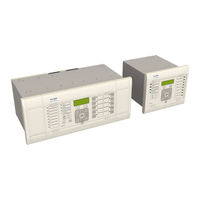GE P643 Manuals
Manuals and User Guides for GE P643. We have 1 GE P643 manual available for free PDF download: Technical Manual
GE P643 Technical Manual (592 pages)
MiCOM P40 Agile Transformer Protection IED
Table of Contents
-
-
Cip27
-
-
Foreword
28-
Cip28
-
Nomenclature29
-
Cip29
-
Compliance
34 -
Symbols
41 -
Front Panel
58 -
Rear Panel
62 -
-
Pcbs64
-
Watchdog68
-
Input Board74
-
IRIG-B Board76
-
RTD Board82
-
CLIO Board83
-
-
-
Interfaces94
-
Chapter Overview
101 -
-
Getting Started103
-
Default Display104
-
Password Entry106
-
Menu Structure107
-
Control Inputs109
-
Function Keys110
-
Phase Rotation
120 -
Chapter Overview
123 -
-
Implementation
131-
Phase Correction132
-
Ratio Correction132
-
Maximum Bias136
-
Delayed Bias136
-
Transient Bias136
-
-
-
Stub Bus Scheme162
-
Chapter Overview
167 -
-
RTD Protection
181 -
CLIO Protection
183 -
Chapter Overview
191 -
-
-
Delayed Bias199
-
Transient Bias199
-
-
Chapter Overview
217 -
-
-
Parallel Feeders233
-
-
-
IDG Curve241
-
Chapter Overview
251 -
Chapter Overview
261 -
-
Chapter Overview
277 -
-
-
Chapter Overview
289 -
Event Records
290-
Event Types290
-
Contact Events291
-
Alarm Events291
-
Security Events296
-
Platform Events296
-
-
Measurements
298 -
Chapter Overview
309 -
-
Resistor Values318
-
Resistor Values320
-
Resistor Values321
-
Chapter Overview
325 -
Scheme Logic
327 -
Function Keys
334 -
Control Inputs
335 -
Chapter Overview
339 -
-
Data Protocols
353-
Courier353
-
Courier Database354
-
Setting Changes354
-
Event Extraction354
-
Iec 60870-5-103358
-
Initialisation359
-
Commands359
-
Test Mode360
-
Dnp361
-
Modbus373
-
MODBUS Functions374
-
Response Codes374
-
Register Mapping375
-
Event Extraction375
-
Setting Changes384
-
Iec 61850388
-
-
Read Only Mode
393 -
Overview
399 -
Standards
401-
NERC Compliance401
-
Cip 002402
-
Cip 007403
-
Ieee 1686-2007403
-
-
-
Blank Passwords407
-
Password Rules407
-
Logging out414
-
Chapter Overview
417 -
-
Terminal Blocks422
-
RS232 Connection425
-
RTD Connections426
-
CLIO Connections427
-
-
Case Dimensions
428 -
Chapter Overview
433 -
-
Test Mode Cell435
-
Test Leds Cell436
-
Product Checks
440-
Insulation441
-
External Wiring441
-
Power Supply442
-
Test LCD443
-
Date and Time443
-
Test Leds444
-
Test Trip LED444
-
Test Opto-Inputs444
-
RTD Inputs445
-
Setting Checks
450 -
Onload Checks
457 -
Final Checks
459 -
Chapter Overview
463 -
Maintenance
464-
Alarms464
-
Opto-Isolators464
-
Output Relays464
-
Replacing Pcbs467
-
Recalibration470
-
Battery Disposal471
-
Cleaning471
-
Troubleshooting
472-
Power-Up Errors472
-
Backup Battery474
-
Chapter Overview
479 -
Interfaces
480-
Rear Serial Port480
-
-
-
R&TTE Compliance494
-
ATEX Compliance494
-
IDMT Standards495
-
Ratings
497 -
Power Supply
498 -
Type Tests
503 -
-
Power Frequency506
Advertisement
Advertisement
